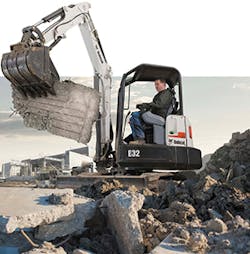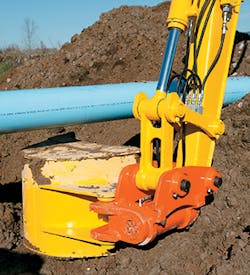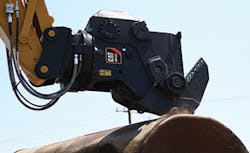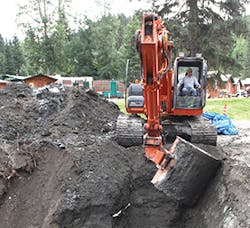If you think about the equipment and skillsets your company already has, it makes perfect sense. No matter if you own the smallest of skid-steers, or the largest of excavators, you’re leaving money on the table if you’re not offering demolition services to your customers. So let’s take a look at some of the latest innovations in this growing product category, and see how they can double and triple your productivity.
Since we mentioned skid-steers, and of course, they’re one of the most common assets in a contractors equipment arsenal, we’ll start with some perspective from Katie Althoff, an attachment specialist at Bobcat Co., Fargo, ND. Althoff notes that breakers are one of the most popular attachments and Bobcat’s products attach easily to their line of excavators and loaders. “Our breakers install in five minutes or less and they’re easily switched over to an excavator, so you have a lot of versatility. And they are great for breaking up an area where you need a little more precision, such as a small sidewalk, or a road repair where you just need to run a sewer system or something.”
Another attachment that performs a similar function is the drop hammer, a large style of breaker that lifts a free falling tool. Drop hammers are useful for flat work such as a parking lots, driveways, and large concrete slabs. It’s not as precise as a breaker, but it’s efficient for large areas such as concrete pads, because it works very quickly and it fractures the concrete and subbase. Breakers and drop hammers are categorized by the foot-pound or joule of impact energy.
When you’re breaking up concrete, it can create plenty of debris and rebar. Those materials can damage a machine’s undercarriage, so Althoff recommends some preventative measures. “It’s very nice to have an excavator with a grapple to go in and clean up the hazardous materials. We have a three-tine grapple on our excavator, and with a clamp you can pin it up and continue to use your bucket, so if you need to dig and use the clamp again, this offers a little more versatility. For demolition projects, they’re great because they don’t pick up things like sand and aggregate-sized sub-base materials. For road construction, demolition crews often recycle a lot of the asphalt and we have a sweeper with a bucket on the inside of it so it’s a broom and a dustpan sweeping up and collecting it, and putting the asphalt shavings into a pile and so they can be recycled.”
Bobcat offers planer attachments that are typically used on asphalt, but they can be used on concrete, and for milling. If you’re taking off a layer of asphalt, a planer will scarify the asphalt, so the new asphalt sticks.
How about a heavy-duty ripper for your skid-steer? These brutes are designed for powerful ripping in applications with caliche, frost, or rock. For example, Paladin Attachments, Dexter, MI, makes rippers that are compatible with most pin-grabbing couplers. It’s available as a pin-on or quick hitch attachment. Paladin also makes the FFC Concrete Claw, designed for removing concrete sidewalks and driveways or on any construction site. It can also be used for shrub and stump removal.
Helac’s PowerTilt pipe
The value of attachments has also been recognized by Hyundai Construction Equipment, Norcross, GA. The manufacturer of earthmoving and material handling equipment recently introduced its first attachment product line to the North American market. Not surprisingly, the line includes 14 models of hydraulic breakers, offering chisel diameters from 1.6–7.9 inches. Operating weights range from 271–12,401 pounds and overall lengths range from 44.4–159.8 inches. The breakers have four chisel options—moil, wedge, blunt, or conical, and are designed for a wide range of demolition applications.
For efficiency, an anti-blank firing (ABF) system prevents the breaker from continuing to strike once material has been demolished, and comes standard on the HDB50–HDB800 models. This system helps protect the chisel pins, tie bolts, and front heads from blank firing and increases theservice life of all components. On the HDB600 and HDB800 models, an energy regeneration valve captures upward flow energy after the piston hits the chisel and retracts back up the cylinder. The technique harnesses up to 15% of the energy to be re-applied on the flow energy back down. This feature increases blow speed without the need for additional flow, resulting in higher production rates.
Gehl is another earthmoving manufacturer that offers a full line of attachments. The company, based in West Bend, WI, offers an attachment line that includes augers, breakers, buckets, compaction plates, frost rippers, grapples, pavement removal buckets, and thumbs. Many of the attachments will find use on Gehl’s new Z80 Compact Excavator. The machine features an advanced hydraulic system designed to enhance engine performance, resulting in a more efficient system.
At Kubota Tractor Corp., Torrance, CA, attachments play a major role in the company’s product offering, but Kubota also looks at remediation as an important task in the process. In mid-2014, Kubota announced availability of its new Hydraulic 6-in-1 Blade for the KX040-4 Compact Excavator. With six different positions, it makes leveling and backfilling, even on inclines and uneven terrain, faster and easier, for improved efficiency and greater productivity. Mounted on the KX040-4 excavator, the Hydraulic 6-in-1 Blade is ideal for contractors looking for 5-ton power in a 4-ton machine. Additionally, the float feature design makes ground-finishing work quick and easy without having to adjust the dozer height. After backfilling, contractors can simply travel backwards along the covered ditch with the dozer in the float position to put the finishing touch on a backfilled trench.
Cat Tank Shear Jaw Multi-Processor with 336E Hydraulic Excavator
Moving up the ladder to heavier equipment, it’s time to get some information from Paul Fabrizius, product application specialist, Caterpillar, Peoria, IL. For the demolition industry, Caterpillar offers grapples, multiprocessors, secondary pulverizers, and shears. The multiprocessor is a perfect example of an industry trend to provide multifunctionality in attachments, says Fabrizius. “The key to the multiprocessor is you have many different tasks possible. Operators can change to different jaws for six different applications. So if you’re doing primary demolition or doing secondary demolition, you change the jaws out based on whether it’s concrete or steel.”
The multiprocessor has a fast recycle time to increase productivity, and the jaw change time is about 12 minutes, and the change can be done by just one person. Contractors can benefit from the fast operations when it comes to demolition and sorting. “A multiprocessor will take the steel structure down and then change the jaws to cut the metal to mill-grade lengths, depending on whether it’s going to a blast furnace or electric-fired furnace. The product range matches our excavators from the 315 all the way up or 390, and the multiprocessor MP3 24, matches up with our ultrahigh.
Doing more with less equipment is the new mantra of demolition, and combination attachments are helping contractors, according to Kevin Loomis, VP business line manager of CTD Hydraulic Attachments, Atlas Copco, in Pinebrook, NJ. “In the past you had specialized pieces of equipment and an excavator would be a bucket moving dirt,” says Loomis. “But as more attachments were designed to make excavators more versatile, new ideas came along. For example, we have a product call the Combi Cutter and it takes multiple jaw sets. Each of those has a specific function, so you could have one is good for primary demolition and it has a high number of teeth for handling concrete and brick, and that takes the outside shell of the structure off. Then with the same unit you can take the jaws out and put in steel cutting jaws and now you have a tool that can go and cut the I-beams, the H-beams, the cables, and angle iron. Now you have one machine on the site, and one operator, and one investment in an attachment with a couple of different jaw sets.”
With the advent of long-reach excavators, these cutters are replacing the process of wrecking balls and explosives. “These products can mount on long reach excavators and allow you to demolish a structure by dismantling it from the top down,” says Loomis. “In doing so, you can process the material as it’s coming down and put all of concrete in one file and steel in another pile, and it’s ready to be hauled off or reused in the next process. It takes longer to take apart a structure, but when you get to the bottom, everything is processed and everything is recyclable. So the contractor has earned more money because the process has been more efficient.”
Atlas Copco has a full line of demolition-related attachments, but two of the most interesting are the magnet and the bucket crusher. The hydraulic magnet has its generator enclosed in its housing, so it’s a self-contained attachment that doesn’t require an excavator with a generator set.
Tilting bucket in a deep hole
The bucket crusher is like the standard bucket on an excavator in its size and scope. However, when you turn the bucket upward, an internal jaw type crusher and when you scoop up the crushes the demolished material into smaller pieces. “You can process material right on the job site without having to haul it to another location or to a large crushing facility,” says Loomis. “So it opens up a lot of opportunities for efficiencies and profits to a small contractor—by doing many more processes directly onsite with one excavator and with products such as a breaker, pulverizer, and grapple, and then finish up the day by pulling the metal out of the concrete with the magnet, and finally, by reducing to a fine size for use as a fill or recycling.”
For contractors that like to get their hands dirty, Atlas Copco also has a full complement of handheld tools, including mechanical and hydraulic paving breakers. “We also have gasoline-powered breakers that will cut asphalt and drill and cut and break down concrete,” Loomis adds. “So there really is a solution for every type of application whether it’s air driven hydraulic or powered with a gasoline internal combustion engine.”
Tightening profit margins are driving today’s contactor to expect more from their equipment fleet. The patented Allied-Gator MT Series Multi-Tool provides contractors a powerful, versatile, and heavy-duty line of demolition attachments, according to Michael Ramun, marketing director, Allied Gator, Youngstown, OH. Offering the largest size range of any multi-processor line, the Allied-Gator MT is available in 11 sizes ranging from 800–52,000 pounds, accommodating the widest range of demolition machines in the industry. The MT mounts to micro-sized remote controlled demolition machines, skid-steers, mini-excavators, backhoes, mid-sized and mass excavators, as well as high-reach machines. The Allied-Gator MT adds a powerful and versatile demolition capacity to any contractor’s existing equipment fleet, notes Ramun.
If those shears have taken down a concrete structure, a contractor could process the material with a screener crusher. For example, Allu Group, Teterboro, NJ, offers its ALLU D-Series Screener Crusher Bucket attachment, which works with wheel loaders, excavators, skid-steers, or backhoes. It screens, crushes, pulverizes, aerates, blends, mixes, separates, and ultimately, feeds and loads materials all in one stage.
Demolition projects can offer some tough situations, and one of the toughest is the removal of concrete in wet conditions. According to the experts at Alpine Sales & Rental Corp., Bellefonte, PA, working in the presence of water reduces the efficiency of an excavation operation by severely limiting the capacity of equipment. Alpine’s drum cutters are designed to improve control in scaling in wet or dry conditions, and the cutter heads crush concrete to a size that can be used as fill matter onsite.
Alpine also offers a wide variety of soil remediation equipment designed to simplify the neutralization of contaminants. Its rock and concrete cutting tools have been repurposed for soil mixing, remediation, and stabilization. The majority of Alpine equipment can be attached to standard excavators, backhoes, and skid-steer loaders.
Grapples are handy attachments for moving debris. The Rotobec Power Attachment, from Rotobec, Sainte Justine, QC, can handle various types of materials, thanks to configuration options including rake, bucket, demolition, and trash.
So far, we’ve seen a wealth of demolition attachments, and all of them offer gains in efficiency, but let’s take a minute to talk about an additional way of getting even more efficiency from your investment. How? By taking advantage of products that improve the performance of your attachments. We might call these attachments for attachments. For example, there is the PowerTilt, from Helac Corp., Enumclaw, WA. This PowerTilt is a tilting coupler that fits all brands of excavators from 5 tons up to 30 ton machines. It also works on backhoe loaders and can handle a variety of attachments. “It’s used often with standard and trenching and grading buckets and ripping tools and demolition hammers,” says Jessica Howisey, marketing communications manager at Helac. “The controls are integrated, and you have a 180–90° tilt control, so when you’re getting into a tight workspace or working on a hill it helps you position the tool. You can increase your productivity by 50% on a task because instead of moving an entire machine you’re just repositioning the bucket. And you can eliminate the use of extra machines onsite, because one excavator can handle all the tasks that one couldn’t without the tilting option. There are also savings on fuel—and think about the labor when you don’t need workers coming in with shovels.” Helac also has a product to speed up bucket changes: a hydraulic coupler that allows an equipment operator to change buckets from inside the cab.
Moving back into the heavy equipment category, we’ve discussed attachments for a variety of vehicles, but what about the workhorse of the road construction industry—the mighty dozer? It’s hard to imagine a structure that can get in the ring with a dozer and survive a direct hit from that massive blade. And what about those rippers on the rear? These machines can tear up a road quickly. Moreover, dozers keep getting bigger. For example, John Deere Construction Equipment, Moline, IL recently introduced the 1050K Crawler Dozer, the largest, most powerful dozer ever built by the company. It’s powered by an EPA Final Tier 4/EU Stage IV PowerTech diesel engine with 350 horsepower (261 kW).
Bobcat’s Pro Clamp System
The 1050K also boasts sophisticated electronics. Before starting a project, operators can set the maximum desired ground speed, and the power management system automatically maintains peak engine revolutions per minute and power efficiency without stalling or shifting. A Total Machine Control monitor allows an operator to select decelerator mode and response—forward/reverse ground speed ranges, steering modulation, F-N-R shift rate, and forward/reverse speed ratios.
If you need something more precise than giant tines ripping up concrete, a cutter makes for a neat alternative. For example, Vermeer Manufacturing Co., Pella, IA, makes a concrete cutter that handles patchwork and joint repair on interstates, streets, and highways. The company also makes a wide variety of handheld concrete saws, with power ranges up to 69 horsepower.
With so many options and categories of demolition equipment to choose from, settling on the most cost-effective attachment can be a daunting task. But there’s an alternative to buying without trying. Instead, take a look at renting, says Wilhelm Chip Kogelmann, president at Alpine. Kogelmann notes that renting makes it easy to discover the efficiency of new attachments, such as hydraulic rock and concrete grinding attachments.
“In terms of demolition and refurbishment, grinders are frequently used for finishing concrete surfaces prior to refurbishment,” Kogelmann explains. “In structures like the walls of canals, concrete deteriorates and starts to fall off. So you need to grind off those spots about 3 to 6 inches and then resurface with new concrete. We rent a lot of grinders for doing that kind of work. We call them rock wheels and they’re also known as cutter head attachments. It’s an excavator attachment and one of the big advantages is that the material you’re left with is usable onsite for tasks such as back fill. Also, in populated areas where there are noise restrictions or shock and vibration concerns, grinders work better than hammers. When you have critical infrastructure like gas lines nearby it’s important.”
Another new product at Alpine is the cutter bucket. It’s like a standard cutter head, but it’s integrated into a bucket. The benefit of design is efficiency. “You can cut and muck out material with the same tool rather than having a second machine present to clean up after the cutting machine does its job,” says Kogelmann. “And you don’t have to change the cutter head and disconnected hydraulic hoses, because the that’s an opportunity to introduce contamination into the hydraulic system. You can also use the cutter bucket as a crusher, to scoop up material such as larger rock or demolition debris, and then run the grinder. It crushes the material which falls out of the bottom of the bucket.” Alpine keeps a large inventory of attachments and other tools on hand, and ships them nationwide. Kogelmann recommends one to two weeks advance notice to assure availability.
Ultimately, whether you’re renting or buying, demolition attachments can have a huge impact on your bottom line. You’ll get more efficiency from equipment like excavators and loaders, and more productivity from your operators. Your opportunities to offer more services can keep your equipment and staff busy.






